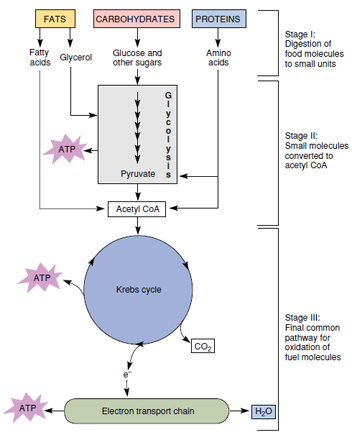Overview of Respiration
Overview of Respiration
Aerobic metabolism is more familiarly
known as true cellular respiration,
defined as the oxidation of fuel molecules
with molecular oxygen as the
final electron acceptor. As mentioned
previously, the oxidation of fuel molecules
describes the removal of electrons and not the direct combination of
molecular oxygen with fuel molecules.
Let us look at this process in general
before considering it in more detail.
Hans Krebs, the British biochemist who contributed so much to our understanding of respiration, described three stages in the complete oxidation of fuel molecules to carbon dioxide and water (Figure 4-10). In stage I, foodstuffs passing through the intestinal tract are digested into small molecules that can be absorbed into the circulation. There is no useful energy yield during digestion, which is discussed in Digestion and Nutrition. In stage II, most of the degraded foodstuffs are converted into two 3-carbon units (pyruvic acid) in the cell cytoplasm. The pyruvic acid molecules then enter mitochondria, where in another reaction they join with a coenzyme (coenzyme A) to form acetyl-CoA. Some ATP is generated in stage II, but the yield is small compared with that obtained in stage III of respiration. In stage III the final oxidation of fuel molecules occurs, with a large yield of ATP. This stage takes place entirely in mitochondria. Acetyl coenzyme A is channeled into the Krebs cycle where the acetyl group is completely oxidized to carbon dioxide. Electrons released from acetyl groups are transferred to special carriers that pass them to electron acceptor compounds in the electron transport chain. At the end of the chain the electrons (and the protons accompanying them) are accepted by molecular oxygen to form water.
 |
| Figure 4-10 Overview of cellular respiration, showing the three stages in the complete oxidation of food molecules to carbon dioxide and water. |
Hans Krebs, the British biochemist who contributed so much to our understanding of respiration, described three stages in the complete oxidation of fuel molecules to carbon dioxide and water (Figure 4-10). In stage I, foodstuffs passing through the intestinal tract are digested into small molecules that can be absorbed into the circulation. There is no useful energy yield during digestion, which is discussed in Digestion and Nutrition. In stage II, most of the degraded foodstuffs are converted into two 3-carbon units (pyruvic acid) in the cell cytoplasm. The pyruvic acid molecules then enter mitochondria, where in another reaction they join with a coenzyme (coenzyme A) to form acetyl-CoA. Some ATP is generated in stage II, but the yield is small compared with that obtained in stage III of respiration. In stage III the final oxidation of fuel molecules occurs, with a large yield of ATP. This stage takes place entirely in mitochondria. Acetyl coenzyme A is channeled into the Krebs cycle where the acetyl group is completely oxidized to carbon dioxide. Electrons released from acetyl groups are transferred to special carriers that pass them to electron acceptor compounds in the electron transport chain. At the end of the chain the electrons (and the protons accompanying them) are accepted by molecular oxygen to form water.




